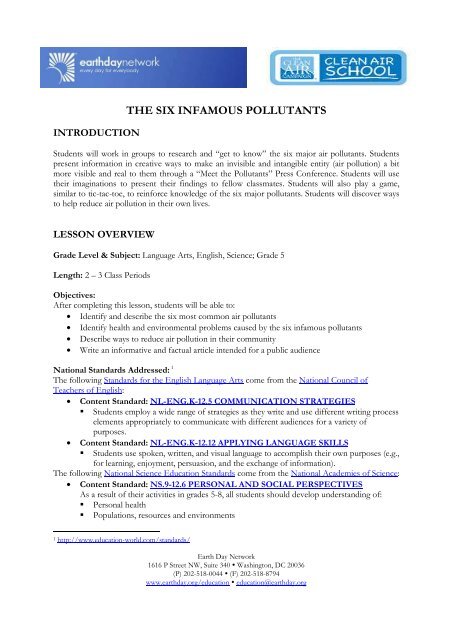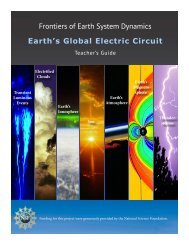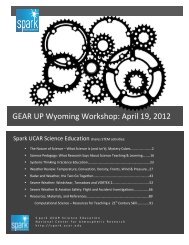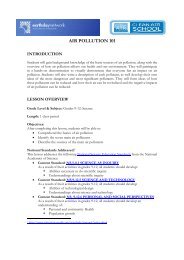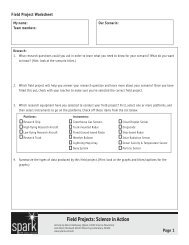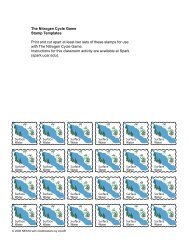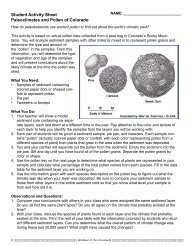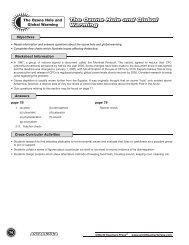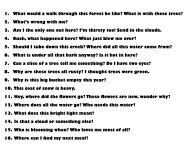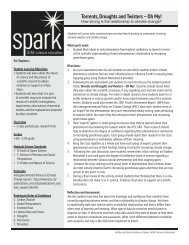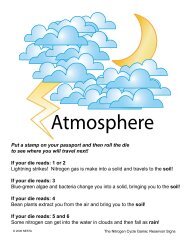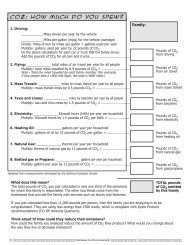#14 - The Six Infamous Pollutants - Salsa!
#14 - The Six Infamous Pollutants - Salsa!
#14 - The Six Infamous Pollutants - Salsa!
Create successful ePaper yourself
Turn your PDF publications into a flip-book with our unique Google optimized e-Paper software.
INTRODUCTION<br />
THE SIX INFAMOUS POLLUTANTS<br />
Students will work in groups to research and “get to know” the six major air pollutants. Students<br />
present information in creative ways to make an invisible and intangible entity (air pollution) a bit<br />
more visible and real to them through a “Meet the <strong>Pollutants</strong>” Press Conference. Students will use<br />
their imaginations to present their findings to fellow classmates. Students will also play a game,<br />
similar to tic-tac-toe, to reinforce knowledge of the six major pollutants. Students will discover ways<br />
to help reduce air pollution in their own lives.<br />
LESSON OVERVIEW<br />
Grade Level & Subject: Language Arts, English, Science; Grade 5<br />
Length: 2 – 3 Class Periods<br />
Objectives:<br />
After completing this lesson, students will be able to:<br />
• Identify and describe the six most common air pollutants<br />
• Identify health and environmental problems caused by the six infamous pollutants<br />
• Describe ways to reduce air pollution in their community<br />
• Write an informative and factual article intended for a public audience<br />
National Standards Addressed: 1<br />
<strong>The</strong> following Standards for the English Language Arts come from the National Council of<br />
Teachers of English:<br />
• Content Standard: NL-ENG.K-12.5 COMMUNICATION STRATEGIES<br />
Students employ a wide range of strategies as they write and use different writing process<br />
elements appropriately to communicate with different audiences for a variety of<br />
purposes.<br />
• Content Standard: NL-ENG.K-12.12 APPLYING LANGUAGE SKILLS<br />
Students use spoken, written, and visual language to accomplish their own purposes (e.g.,<br />
for learning, enjoyment, persuasion, and the exchange of information).<br />
<strong>The</strong> following National Science Education Standards come from the National Academies of Science:<br />
• Content Standard: NS.9-12.6 PERSONAL AND SOCIAL PERSPECTIVES<br />
As a result of their activities in grades 5-8, all students should develop understanding of:<br />
<br />
<br />
Personal health<br />
Populations, resources and environments<br />
1 http://www.education-world.com/standards/<br />
Earth Day Network<br />
1616 P Street NW, Suite 340 Washington, DC 20036<br />
(P) 202-518-0044 (F) 202-518-8794<br />
www.earthday.org/education education@earthday.org
Environmental quality<br />
Natural hazards<br />
Science and technology in society<br />
Materials Needed:<br />
• Chart paper and marker<br />
• Reproducible #1 – <strong>Six</strong> <strong>Infamous</strong> <strong>Pollutants</strong><br />
• Reproducible #2 – <strong>Six</strong> <strong>Infamous</strong> <strong>Pollutants</strong> Assessment Rubric<br />
• Reproducible #3 – <strong>Infamous</strong> Pollutant Biography<br />
• Reproducible #4 – <strong>Infamous</strong> <strong>Pollutants</strong> Biography – Sample Student Answers<br />
• Reproducible #5 – Meet the <strong>Pollutants</strong> Press Conference – Reporter's Notes<br />
• Reproducible #6 – “O” Game Pieces and “O” Questions<br />
• Reproducible #7 – “X” Game Pieces and “X” Questions<br />
• Reproducible #8 – Tic-Tac-Toe Board<br />
• Game pieces<br />
• Computers with Internet access and/or other air pollution reference materials<br />
• A variety of art materials for presentation props (Students should also contribute)<br />
• Cardstock, binder ring or other materials for binding the "Air Quality Journal"<br />
• Newspaper clippings about air quality issues (optional)<br />
Assessment:<br />
Students will be assessed through the following activities:<br />
• Completed research, using web sites and/or texts<br />
• Completion of Reproducible #3 – <strong>Infamous</strong> Pollutant Biography<br />
• Contributed to group presentation<br />
• Recorded notes from press conference<br />
• Participation in tic-tac-toe games<br />
• Completion of article for Air Quality Journal<br />
LESSON BACKGROUND<br />
Relevant Vocabulary:<br />
• Air pollution: Air pollution occurs when the air contains gases, dust, fumes or odor in harmful<br />
amounts. That is, amounts which could be harmful to the health or comfort of humans and<br />
animals or which could cause damage to plants and materials. <strong>The</strong> substances that cause air<br />
pollution are called pollutants. <strong>Pollutants</strong> that are pumped into our atmosphere and directly<br />
pollute the air are called primary pollutants. Primary pollutant examples include carbon<br />
monoxide from car exhausts and sulfur dioxide from the combustion of coal. Further pollution<br />
Earth Day Network<br />
1616 P Street NW, Suite 340 Washington, DC 20036<br />
(P) 202-518-0044 (F) 202-518-8794<br />
www.earthday.org/education education@earthday.org
can arise if primary pollutants in the atmosphere undergo chemical reactions. <strong>The</strong> resulting<br />
compounds are called secondary pollutants. Photochemical smog is an example of this. 2<br />
• Air Quality: A measurement of the pollutants in the air; a description of healthiness and safety<br />
of the atmosphere. 3<br />
• Environmental Protection Agency (EPA): An agency established in 1970 by the United<br />
States government to coordinate federal programs aimed at combating pollution and protecting<br />
the environment. 4<br />
• U.S. Clean Air Act: <strong>The</strong> Clean Air Act is the law that defines EPA's responsibilities for<br />
protecting and improving the nation's air quality and the stratospheric ozone layer. <strong>The</strong> last<br />
major change in the law, the Clean Air Act Amendments of 1990, was enacted by Congress in<br />
1990. Legislation passed since then has made several minor changes. 5<br />
Background Information:<br />
<strong>The</strong> U.S. Clean Air Act stipulates that the Environmental Protection Agency (EPA) set air<br />
quality standards for the six most common air pollutants that are found all over the nation. <strong>The</strong>se<br />
include: Sulfur Dioxide, Carbon Monoxide, Ground-Level Ozone, Particulate Matter, Nitrogen<br />
Oxide and Lead. To help teach this lesson, here is a little more information on each of these<br />
pollutants. It is important to note that all of these pollutants occur naturally in the environment.<br />
However, they become harmful to public health and the environment when they are produced in<br />
large quantities that are contrary to a natural state.<br />
Sulfur dioxide is a highly reactive gas. It is released naturally through volcanoes but the largest<br />
amounts of emissions come from fossil fuel combustion at power plants and other industrial<br />
facilities. In humans, sulfur dioxide affects the respiratory system causing difficulty in breathing, and<br />
even premature death. Sulfur dioxide is also particularly harmful for the environment, harming both<br />
plant and animal life. Sulfur dioxide contributes to acid rain.<br />
Carbon Monoxide is a colorless, odorless and tasteless gas emitted from combustion processes.<br />
Although found naturally in the human body, in large quantities, it is extremely harmful to both<br />
animals and humans. <strong>The</strong> largest amounts of carbon monoxide come from cars, planes and other<br />
forms of transportation. By reducing the delivery of oxygen to the body’s organs and tissues, high<br />
levels of carbon monoxide will effect the cardiovascular system and can even cause death.<br />
Ozone is formed from the emissions of NOx and VOC’s, which occur naturally but are also emitted<br />
in the largest quantities from motor vehicle exhaust and industrial emissions. Ground-level ozone<br />
contributes to smog. Because sunlight and hot weather causes dangerous concentrations of groundlevel<br />
ozone, summer is the most harmful season for this pollutant. Breathing ozone can cause chest<br />
2 “What is Air Pollution.” Environmental Protection Agency, Victoria, Retrieved June 2, 2011 from <<br />
http://www.epa.vic.gov.au/air/aq4kids/pollution.asp>.<br />
3 “Air Quality” Entry. Dictionary.com, LLC. Retrieved April 5, 2011 from<br />
http://dictionary.reference.com/browse/air+quality.<br />
4 “Environmental Protection Agency Entry.” Webster’s Online Dictionary. Retrieved 2 June 2011 from<br />
http://www.websters-online-dictionary.org/definitions/EPA?cx=partner-pub-0939450753529744%3Av0qd01-<br />
tdlq&cof=FORID%3A9&ie=UTF-8&q=EPA&sa=Search#906<br />
5 “Clean Air Act.” U.S. Environmental Protection Agency. Retrieved June 7, 2011 from http://www.epa.gov/air/caa/.<br />
Earth Day Network<br />
1616 P Street NW, Suite 340 Washington, DC 20036<br />
(P) 202-518-0044 (F) 202-518-8794<br />
www.earthday.org/education education@earthday.org
pain, coughing, throat irritation and congestion. It also worsens the effects of bronchitis,<br />
emphysema, and asthma.<br />
Particulate Matter (PM) is composed of a variety of small particles and liquid droplets. It can be<br />
made up of both man made and natural particles, such as acids, metals, soil, dust particles, etc.<br />
Volcanoes, dust storms and forest fires are all responsible for particulate matter, as well as the<br />
burning of fossil fuels, power plants and industrial processes. Particulate Matter can be very hard for<br />
the respiratory system, especially for people with pre-existing conditions, including asthma and<br />
bronchitis. <strong>The</strong> fine particles in PM are so tiny that they can get deep into the lungs. PM can also<br />
cause an irregular heartbeat, difficulty in breathing and premature death.<br />
Nitrogen Oxide is formed from car, truck, buses, and power plant emissions. Nitrogen Oxide also<br />
contributes to the formation of ground-level ozone and PM. NOx, like many of the other air<br />
pollutants, affects the respiratory system. Even for healthy people, nitrogen oxide can cause airway<br />
inflammation. Nitrogen Oxide will also worsen the effects of pre-existing conditions, such as asthma<br />
and emphysema.<br />
Lead is a metal found naturally in the environment. However, lead is also emitted into the air from<br />
fuels in motor vehicles and industrial sources. Lead can also be released into the air through ore and<br />
metals processing. Lead is particularily dangerous because it can leak into the food and water supply<br />
to be ingested by people. Lead-based paint that was historically used in houses is also a major<br />
exposure pathway for people. When lead enters the body, it is absorbed into the blood and bones.<br />
Lead can affect the nervous system, kidney function, and immune system, reproductive and<br />
developmental and cardiovascular systems. Lead also adversely affects the environment; it has been<br />
show to cause loss of biodiversity, decreased growth and reproductive rates in plants and animals.<br />
Although air pollution is a significant problem with no easy solution, there are some ways<br />
individuals can help. First of all, reducing the reliance on cars and trucks and using alternatives, such<br />
as public transportation and bikes will significantly reduce many of these pollutants. Also, writing<br />
letters to local and state governments to invest in cleaner energy alternatives will encourage the<br />
government to find ways to protect the air. Please check the EPA site for more information:<br />
http://www.epa.gov/oaqps001/urbanair/.<br />
Resources:<br />
• What are the <strong>Six</strong> Common Air <strong>Pollutants</strong>? U.S. Environmental Protection Agency<br />
http://www.epa.gov/oaqps001/urbanair/<br />
• Cleaning up Commonly Found Air <strong>Pollutants</strong> U.S. Environmental Protection Agency<br />
http://www.epa.gov/air/peg/cleanup.html<br />
• Urban Air Pollution United Nations Environment Programme<br />
http://www.unep.org/urban_environment/issues/urban_air.asp<br />
• Today’s AQI Forecast AIRNow<br />
http://airnow.gov/<br />
Earth Day Network<br />
1616 P Street NW, Suite 340 Washington, DC 20036<br />
(P) 202-518-0044 (F) 202-518-8794<br />
www.earthday.org/education education@earthday.org
LESSON STEPS<br />
Teacher Preparation Steps:<br />
1. Review all steps in this lesson prior to beginning.<br />
2. Collect all items listed in the materials section, and make copies of hand-outs ahead of time.<br />
Reproducible #5 – “O” Game Pieces and “O” Questions and Reproducible #7 – “X”<br />
Game Pieces and “X” Questions should both be printed double sided and cut along the<br />
lines so the questions are on the back of the cards.<br />
3. If students are playing the tic-tac-toe game in pairs, each pair will need:<br />
a. Reproducible #6 – “O” Game Pieces and “O” Questions<br />
b. Reproducible #7 – “X” Game Pieces and “X” Questions<br />
c. Reproducible #8 – Tic-Tac-Toe Board<br />
d. Game pieces (two different kinds to represent “X’s” and “O’s” – dimes and nickels,<br />
two different colored stones, etc.)<br />
4. Each student will need 3 copies of Reproducible #5 – Meet the <strong>Pollutants</strong> Press<br />
Conference – Reporter's Notes to take notes on each of the 6 pollutants.<br />
Warm-up: <strong>The</strong> Air We Breathe<br />
1. Write the words “Air Quality” on the board and ask students the following questions:<br />
a. What do the words Air Quality mean? Air Quality is a measurement of the pollutants in the<br />
air; a description of healthiness and safety of the atmosphere.<br />
b. Is the quality of the air in their geographical area good or bad? Why? Answers will vary<br />
but may include ideas about the amount of trees, cars, factories, people, fog, etc.<br />
c. What evidence is there of air pollution? Answers will vary but may include ideas about fog or<br />
physical symptoms, such as coughing and shortness of breath..<br />
d. Have students ever experienced burning eyes or shortness of breath on polluted<br />
days? Answers will vary.<br />
e. What time of the year does the air seem dirtiest? This answer may vary according to region<br />
but in general, the air seems the dirtiest in summer because of higher particulate matter, higher<br />
humidity and less rain to wash everything away. <strong>The</strong>re also tends to be more pollen in the air during<br />
the summer.<br />
2. Tell students that the issue of “air quality;” – how good or bad the air is - is often in the<br />
news across the country. (Show recent, related news articles if available.)<br />
3. Ask students why there is so much talk about “air quality.”<br />
4. Lead students in a short discussion about the importance of air for living things. Explain that<br />
bad air can contribute to a variety of illnesses such as asthma and cancer. Explain that even<br />
though air is so very important, and we should know what’s going in and out of our lungs,<br />
it’s sometimes hard to grasp because you usually can’t see it, hear, smell, touch, or taste air<br />
pollutants. It will be the students’ challenge to make invisible air and air pollutants visible<br />
and interesting to learn about.<br />
Activity One: Identifying <strong>Pollutants</strong><br />
1. Ask students where air pollution comes from and as they answer, list their responses on the<br />
Earth Day Network<br />
1616 P Street NW, Suite 340 Washington, DC 20036<br />
(P) 202-518-0044 (F) 202-518-8794<br />
www.earthday.org/education education@earthday.org
oard, under the title: “Sources of Air Pollution.” Cars, trucks, airplanes, power plants, big<br />
factories, fireplaces, and gas stations.<br />
2. Ask students to identify what air pollution is actually made of; if students can name any of<br />
the six major pollutants, applaud them for knowing what so many people don’t know about<br />
the air they are breathing. Ozone (Oз), Carbon Monoxide (CO), Nitrogen Oxides (NOx), Sulfur<br />
Dioxide (SO2), Particulate Matter (PM), and Lead (Pb).<br />
3. Display Reproducible #1 – <strong>Six</strong> <strong>Infamous</strong> <strong>Pollutants</strong> on the projector or smart board for<br />
students to see.<br />
4. Explain to students that there are more pollutants, but that these are the “biggies” and they<br />
should be infamous, but many people don’t know anything about them. Tell them that it<br />
will be their job to find out to find out as much as they can about the pollutants and be able<br />
to share that information with others and make the pollutants “infamous.”<br />
5. Divide the class into six groups and assign each group one of the six infamous pollutants.<br />
Distribute Reproducible #2 – <strong>Six</strong> <strong>Infamous</strong> <strong>Pollutants</strong> Assessment Rubric and<br />
Reproducible #3 – <strong>Infamous</strong> Pollutant Biography.<br />
6. Challenge students to treat the Pollutant as an infamous character about whom they are<br />
putting together a biographical sketch. Tell them to use the EPA pollutants and air quality<br />
websites for kids, listed on the hand-out, as well as encyclopedias or other resources, to<br />
answer the questions and get to know their Pollutant very well. Explain that groups will be<br />
preparing this biographical information for a “Meet the <strong>Pollutants</strong>” Press Conference in<br />
which each type of pollutant will be interviewed to find out what they are all about. (Explain<br />
that infamous people often hold press conferences and answer questions by reporters).<br />
Each person in the group will play a particle of whichever pollutant that group was assigned;<br />
each person will speak at the press conference presentation and tell part of the pollutant's<br />
life story (based on information from Reproducible #3 – <strong>Infamous</strong> Pollutant<br />
Biography); and each person in a group should be prepared to answer questions from the<br />
"press."<br />
7. <strong>The</strong> rest of the class will take notes and ask questions, acting as members of the press. Tell<br />
students that the groups may use props, special effects, or simple costumes to make the<br />
invisible pollutant visible and interesting to others. Mention that props also make good<br />
memory devices and help keep a presentation on track. Tell students that each group should<br />
have a main point or focus of its presentation, instead of just reciting a list of facts. For<br />
instance, a pollutant group could emphasize that their pollutant kills kids, or is the most<br />
dangerous, or had a difficult childhood, is not very threatening at all~ and explain how or<br />
why. A sample student presentation is included at the end of this document. Explain to<br />
students that for all activities in this lesson, they should follow the guidelines on the<br />
assessment rubric. At the end of the lesson, the teacher will collect the assessment rubric<br />
and grade accordingly. Be sure to mention that students should fill out the “Self-<br />
Assessment” portion of the rubric to get 5 extra points toward their overall grade.<br />
presentations.<br />
8. As students research and develop materials, circulate and assist them as needed. Encourage<br />
them to be creative yet scientifically accurate. Emphasize that each member of the group<br />
must participate in the presentation, and that each person must fill out his own version of<br />
the Reproducible #3 – <strong>Infamous</strong> Pollutant Biography, even if group members<br />
collaborate on the research. Allow time for the groups to plan and practice their<br />
presentations, after research is complete.<br />
Earth Day Network<br />
1616 P Street NW, Suite 340 Washington, DC 20036<br />
(P) 202-518-0044 (F) 202-518-8794<br />
www.earthday.org/education education@earthday.org
9. After students have completed their research and prepared their presentations, set up the<br />
classroom for the press conference. Provide a central area for the presenters and an<br />
audience area for the rest of the students, who will be acting as reporters.<br />
10. Distribute Reproducible # 5 – Meet the <strong>Pollutants</strong> Press Conference – Reporter's<br />
Notepad. Students will need three note pages each to have one section for each of the six<br />
pollutants.<br />
11. Explain to students that the “reporters” will ask questions, but they must also take good<br />
notes: they will be using their notes later. Because students may not be familiar with a press<br />
conference format, the teacher will serve as moderator, introducing each Pollutant group,<br />
inviting the presentation to start, asking the first question, and guiding the audience to ask<br />
subsequent questions. You might want to add some humor by calling the <strong>Pollutants</strong> by<br />
names, such as Ms. CO (carbon monoxide), Mr. Pib (Lead), or Dr. Nox (nitrogen oxide).<br />
Allow each pollutant 5 – 10 minutes for their presentation and interview. After each session,<br />
be sure to applaud the presenters and briefly highlight the important points relating to the<br />
source of the pollutant, its effects on living things, and what can be done about it.<br />
12. Congratulate the entire class on an exciting press conference and their ability to make<br />
invisible things that are hard to grasp much more visible and understandable.<br />
Activity Two: Air Quality Tic-Tac-Toe<br />
1. Tell students they are now going to play a game to go further in-depth into the <strong>Six</strong> <strong>Infamous</strong><br />
Air <strong>Pollutants</strong> better. This Tic-Tac-Toe game is similar to the "Hollywood Squares" game on<br />
T.V.<br />
2. Ask students to rearrange their desks so nine students are set up like a Tic-Tac-Toe board in<br />
the middle of the classroom with three rows of three. Assign each of these students one of<br />
the six <strong>Infamous</strong> Pollutant personalities listed above. One student is Ms. / Mr. Earth, one is<br />
Ms. / Mr. Dir. T. Air, and another is Dr. Haze. <strong>The</strong> remainder of the students should be<br />
divided into two teams, one Team X and the other Team O. A student or the teacher may<br />
serve as the Game Show Host who will ask the questions.<br />
3. To start this game, a player from Team X chooses one of the “celebrities” to answer a<br />
question. <strong>The</strong> host reads a question from an X card (please see Teacher Preparation Step)<br />
and the celebrity answers, giving either a correct or an incorrect answer. <strong>The</strong> Team X player<br />
must decide if the answer given by the celebrity is correct or incorrect. If it is a correct<br />
answer, the Team X player wins the square and the host gives an X card to the celebrity to<br />
hold. This is repeated with the O team and continued until one team makes a Tic Tac Toe or<br />
the board is filled. OR If the class works better in smaller groups, divide the class into<br />
multiple teams of two students each. Give each team of two a copy of Reproducible #8 –<br />
Tic-Tac-Toe Board, Reproducible #6 – “O” Game Pieces and “O” Questions,<br />
Reproducible #7 – “X” Game Pieces and “X” Questions and Game Pieces. Have<br />
students cut out the questions and game pieces.<br />
4. Tell students that the game is played like Tic-Tac-Toe except they must answer a question<br />
correctly before they can claim a space. <strong>The</strong> "X" player asks questions from the "X"<br />
Question cards. Similarly, the "O" player asks the "X" player questions off the "O" Question<br />
cards. A player can only place their piece on the Game Board card when a question is<br />
answered correctly.<br />
Earth Day Network<br />
1616 P Street NW, Suite 340 Washington, DC 20036<br />
(P) 202-518-0044 (F) 202-518-8794<br />
www.earthday.org/education education@earthday.org
Activity Three: Alerting the Public<br />
1. Tell students that many people don’t know much about these <strong>Infamous</strong> <strong>Pollutants</strong> and yet<br />
they are in contact with them often. Now that the students know the pollutants well, it’s<br />
time they share this important knowledge with others. Assign students to choose three of<br />
the six major air pollutants and write an article for the “Air Quality Journal” using notes<br />
from Reproducible #3 – <strong>Infamous</strong> Pollutant Biography and Reproducible #5 – Meet<br />
the <strong>Pollutants</strong> Press Conference – Reporter's Notes <strong>The</strong> article must be at least three<br />
paragraphs long, describing to the general public where the pollutants come from, how they<br />
are caused, their effects on living things, and what can be done about them. In addition to<br />
the information about each pollutant, the article must compare the three pollutants, pointing<br />
out similarities and differences, and must make a main point (such as which pollutant is the<br />
worst, which affects the most students in your community, or which presents a problem<br />
students have the power to help solve). <strong>The</strong> article will differ in point of view from the press<br />
conference presentations, which were conducted "in character." For purposes of this article,<br />
students should write as junior scientists. Please refer students to their copies of<br />
Reproducible #2 – Assessment Rubric for additional information on criteria for this<br />
assignment. <strong>The</strong> articles may be started in class and continued as a homework assignment.<br />
2. After articles are submitted, bind the articles into a “magazine” and entitle it “Air Quality<br />
Journal.” You may wish to add newspaper clippings and other pertinent information to the<br />
Journal as the class proceeds through the Air Quality unit. Please remind students that their<br />
Pollution Biography Worksheets and Reporter's Notepads should also be turned in, along<br />
with Reproducible #2 – <strong>Six</strong> <strong>Infamous</strong> <strong>Pollutants</strong> Assessment Rubric.<br />
Wrap Up: Discussion<br />
1. Begin a discussion with students.<br />
a. What did you learn during these activities? Answers will vary.<br />
b. Why is it important to be aware of air pollution? Answers will vary.<br />
c. How can you make other people more aware of conditions of the air they breathe?<br />
Answer will vary.<br />
d. What did you find were the best ways to improve air quality in your own<br />
community? Answers will vary but make sure to mention the importance of education to students<br />
and making people aware of what causes air pollution.<br />
Extension: Takin’ it to the School!<br />
1. Students can work in teams to make posters, PSA’s, songs, raps or skits about the<br />
importance of healthy air. Have students display their artwork or performance for other<br />
classes to raise awareness around the school.<br />
Earth Day Network<br />
1616 P Street NW, Suite 340 Washington, DC 20036<br />
(P) 202-518-0044 (F) 202-518-8794<br />
www.earthday.org/education education@earthday.org
Extension: No Idling!<br />
1. Start a no idling campaign at your school or check out other No Idling resources from the<br />
Earth Day Network archive. 6<br />
CONCLUSION<br />
In this lesson students discovered the six most infamous air pollutants. <strong>The</strong>y built their research and<br />
communications skills in order to present information to fellow students about one of the<br />
pollutants, listen to other students presentations and write an article intended for the general public<br />
and included in the Air Quality Journal. As a result of this lesson students can identify the most<br />
dangerous air pollutants and explain the problems they cause, as well as effectively convey their own<br />
opinions in several different forms of communication. Students also discussed tangible ideas for<br />
reducing the amount of air pollution in their own community.<br />
LESSON PLAN CREDITS<br />
<strong>The</strong> Clean Air Campaign, Inc. – Author<br />
Maggie Ollove – Contributor, Editor<br />
Education Associate, Earth Day Network<br />
6 http://www.earthday.org/noidling<br />
Earth Day Network<br />
1616 P Street NW, Suite 340 Washington, DC 20036<br />
(P) 202-518-0044 (F) 202-518-8794<br />
www.earthday.org/education education@earthday.org
<strong>Six</strong> <strong>Infamous</strong> <strong>Pollutants</strong><br />
*Ozone (Oз)<br />
*Carbon Monoxide (CO)<br />
*Nitrogen Oxides (NOx)<br />
*Sulfur Dioxide (SO2)<br />
*Particulate Matter (PM)<br />
*Lead (Pb)<br />
Earth Day Network<br />
1616 P Street NW, Suite 340 Washington, DC 20036<br />
(P) 202-518-0044 (F) 202-518-8794<br />
www.earthday.org/education education@earthday.org
Name: _______________________<br />
Date: _______________________<br />
<strong>Six</strong> <strong>Infamous</strong> <strong>Pollutants</strong> Assessment Rubric<br />
<strong>Infamous</strong> Pollutant Biography<br />
Criteria<br />
Self-<br />
Assessm<br />
ent<br />
Conducted research using websites, books, texts<br />
- Researched using reliable Internet sites and outside<br />
resources<br />
Possible<br />
Points<br />
10<br />
Score<br />
Completed <strong>Infamous</strong> Pollutant Biography<br />
-Took notes that were useful in preparing for Pollutant Press<br />
Conference<br />
- Provided key information, including:<br />
1. Identification and description of pollutant<br />
2. Origins (Cause/where it comes from)<br />
3. Location (Where and when usually found)<br />
4. Effects (Problems, adverse impact)<br />
5. Solutions (How humans can reduce this form of<br />
pollution and/or protect themselves from it.<br />
30<br />
Contributed to Group Presentation<br />
- Presented from the point of view of the pollutant<br />
- Showed individuality/personality (“in character)<br />
- Engaged the audience (Eye contact, audience connection)<br />
15<br />
- Used props and special effects to help audience remember<br />
the presentation<br />
- Appropriate amount/level of information used<br />
- Made a main point effectively/ Presentation had a focus<br />
(i.e. was your pollutant the worst or not really a threat? Does<br />
it have a special danger for kids?, etc.)<br />
Recorded notes from Press Conference (5 parts)<br />
- Kept notes on five pollutants (other than own) 15<br />
Wrote article for Air Quality Journal<br />
- Article written as for a science journal<br />
- Length appropriate (3 paragraph minimum)<br />
- Conveyed information content effectively<br />
- Identified causes and effects of 3 pollutants<br />
30<br />
- Compared pollutants (similar/different)<br />
- Had a focus or main point (i.e. Which pollutant is worst,<br />
What the most effective thing people can do to fight<br />
pollution, how can people protect themselves from pollution<br />
effects, etc.)<br />
Bonus – completed self- assessment column 5<br />
Total 100+<br />
Earth Day Network<br />
1616 P Street NW, Suite 340 Washington, DC 20036<br />
(P) 202-518-0044 (F) 202-518-8794<br />
www.earthday.org/education education@earthday.org
1) What do you look like?<br />
Name of Pollutant: ______________________________<br />
2) Where do you come from?<br />
3) Where do you hang out?<br />
4) What problems do you cause for humans and other living things?<br />
5) What are humans doing to stop you from doing more harm?<br />
6) What special effects, props or costumes will you use for the press conference?<br />
Earth Day Network<br />
1616 P Street NW, Suite 340 Washington, DC 20036<br />
(P) 202-518-0044 (F) 202-518-8794<br />
www.earthday.org/education education@earthday.org
<strong>Infamous</strong> Pollutant Biography – Sample Student Answers<br />
Name of Pollutant: ___Nitrogen Oxides (Dr. Nox)__________<br />
1) What do you look like?<br />
<strong>The</strong>re are actually lots of nitrogen oxides in my family. I am colorless and you can’t smell me either. But there are some<br />
in my family that look kind of red-brown when they hang over cities. (* Student might sprinkle red-brown dust to<br />
illustrate or show a picture with red-brown hanging over a city.)<br />
2) Where do you come from?<br />
I come from things that burn fuel – like cars (* Student might show picture of cars or tailpipes and/or make the<br />
sound of a car engine revving). I also come from factories (show a picture of smokestack) and from utilities like electric<br />
power plants (student might flash the classroom lights.)<br />
3) Where do you hang out?<br />
I’m a traveler – I blow on the wind (student blows or waves a large cloth). I like to hang out over cities, but I can<br />
spread far and wide.<br />
4) What problems do you cause for humans and other living things?<br />
Lots! I can mix with other things called volatile compounds and heat and sunlight to make ozone and that can<br />
damage human lungs. (Student holds picture of lungs.) I can also mix with particles and cause problems to the lungs.<br />
I can mix with sulfur dioxide and make acid rain. (Sound of rain or picture of rain) That can make damage crops<br />
and fish and other things in the water.<br />
I can also add extra nitrogen to the water and that messes up lakes and streams. (Hold up bottle of water or show<br />
picture of lake.)<br />
Some of my family members work on global warming - -making the earth heat up. And that changes the whole climate<br />
everywhere (act out feeling very hot or show picture of global warming)<br />
I can also mix with other things and make poison! (Show skull and cross bones.) And sometimes I make it hard for<br />
people to see things clearly because I block the sunlight (squint).<br />
5) What are humans doing to stop you from doing more harm?<br />
<strong>The</strong>y made a law called the Clean Air Act to try to stop the factories and the electric companies from making so much<br />
of me. <strong>The</strong>y’re trying to make cleaner burning fuel for cars (quieter sound of engine revving). And some humans aren’t<br />
driving cars as much – they ride buses, walk to places, or ride bikes. (Act out walking and biking). But right now,<br />
I’m still pretty powerful! (Show muscles.)<br />
Earth Day Network<br />
1616 P Street NW, Suite 340 Washington, DC 20036<br />
(P) 202-518-0044 (F) 202-518-8794<br />
www.earthday.org/education education@earthday.org
Meet the <strong>Pollutants</strong> Press Conference – Reporter’s Notes<br />
Pollutant Name: ___________________________________<br />
What does it look like?<br />
Where is it from?<br />
Where does it hang out?<br />
What problems does it cause?<br />
What is being done about it?<br />
*******************************************************************************************<br />
Pollutant Name: ______________________________________<br />
What does it look like?<br />
Where is it from?<br />
Where does it hang out?<br />
What problems does it cause?<br />
What is being done about it?<br />
Earth Day Network<br />
1616 P Street NW, Suite 340 Washington, DC 20036<br />
(P) 202-518-0044 (F) 202-518-8794<br />
www.earthday.org/education education@earthday.org
<strong>Six</strong> <strong>Infamous</strong> Air <strong>Pollutants</strong><br />
“O” Game Pieces<br />
O O O<br />
O O O<br />
O O O<br />
Earth Day Network<br />
1616 P Street NW, Suite 340 Washington, DC 20036<br />
(P) 202-518-0044 (F) 202-518-8794<br />
www.earthday.org/education education@earthday.org
<strong>Six</strong> <strong>Infamous</strong> Air <strong>Pollutants</strong><br />
“O” Questions<br />
O Cards<br />
_________ is a gas<br />
composed of three oxygen<br />
atoms.<br />
Answer: Ozone (Oз).<br />
O Cards<br />
Name the four components<br />
that combine to produce<br />
ground-level ozone.<br />
Answer: VOCs, NOx,<br />
heat and sunlight.<br />
O Cards<br />
What are some sources of<br />
nitrogen oxides (NOx)?<br />
Answer: Motor vehicle<br />
exhaust, industrial emissions,<br />
gasoline vapor, chemical<br />
solvents.<br />
O Cards<br />
ame a colorless, odorless gas<br />
hat is formed when carbon in<br />
uel is not burned completely.<br />
nswer: Carbon Monoxide.<br />
O Cards<br />
Name a metal found in the<br />
environment.<br />
Answer: Lead.<br />
O Cards<br />
Describe how pollutants can<br />
contribute to health problems.<br />
Answer: Can cause heart<br />
and lung problems,<br />
especially for the elderly,<br />
the young and those who<br />
have asthma, etc.<br />
O Cards<br />
Ground-level ozone occurs<br />
mostly during what season?<br />
Answer: Summer.<br />
O Cards<br />
What type of pollutant includes<br />
dust, dirt, soot, smoke and liquid<br />
droplets?<br />
Answer: Particulate Matter.<br />
O Cards<br />
Which pollutant comes mostly<br />
from electric plants that burn<br />
coal?<br />
Answer: SO2.<br />
Earth Day Network<br />
1616 P Street NW, Suite 340 Washington, DC 20036<br />
(P) 202-518-0044 (F) 202-518-8794<br />
www.earthday.org/education education@earthday.org
<strong>Six</strong> <strong>Infamous</strong> Air <strong>Pollutants</strong><br />
“X” Game Pieces<br />
X X X<br />
X X X<br />
X X X<br />
Earth Day Network<br />
1616 P Street NW, Suite 340 Washington, DC 20036<br />
(P) 202-518-0044 (F) 202-518-8794<br />
www.earthday.org/education education@earthday.org
X Cards<br />
What type of pollutant includes<br />
microscopic particles and tiny<br />
droplets of liquid?<br />
Answer: Particulate matter.<br />
<strong>Six</strong> <strong>Infamous</strong> Air <strong>Pollutants</strong><br />
“X” Questions<br />
X Cards<br />
During the summer in large<br />
urban areas like Atlanta, which<br />
pollutant causes the most air<br />
pollution?<br />
Answer: Ground-level<br />
ozone.<br />
X Cards<br />
What is the major harm<br />
ingredient in smog?<br />
Answer: Ground-lev<br />
ozone.<br />
X Cards<br />
What pollutants contribute to health<br />
problems?<br />
Answer: All of them.<br />
X Cards<br />
Which pollutants can travel great<br />
distances on air currents?<br />
Answer: Nitrogen oxides.<br />
X Cards<br />
What are the 6 major<br />
pollutants?<br />
Answer: Ground-level<br />
ozone, carbon monoxide,<br />
nitrogen dioxide, sulfur<br />
dioxide, particulate matter<br />
and lead.<br />
X Cards<br />
Name three air pollutants that<br />
will be reduced if people drive<br />
less.<br />
Answer: Ozone, carbon<br />
monoxide and nitrogen<br />
oxides.<br />
X Cards<br />
Name this pollutant: Larger typ<br />
be stopped in the nose and upp<br />
lungs by the body’s natural def<br />
Smaller types escape the body’s<br />
defenses and go deep into the<br />
where they may become trappe<br />
Answer: Particulate Ma<br />
X Cards<br />
Which pollutant stops ox<br />
from getting to the bod<br />
organs?<br />
Answer: Carbon mono<br />
Earth Day Network<br />
1616 P Street NW, Suite 340 Washington, DC 20036<br />
(P) 202-518-0044 (F) 202-518-8794<br />
www.earthday.org/education education@earthday.org
<strong>Six</strong> <strong>Infamous</strong> Air <strong>Pollutants</strong><br />
Tic-Tac-Toe Board<br />
Earth Day Network<br />
1616 P Street NW, Suite 340 Washington, DC 20036<br />
(P) 202-518-0044 (F) 202-518-8794<br />
www.earthday.org/education education@earthday.org


